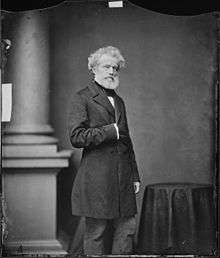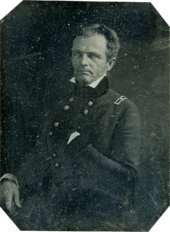John A. Quitman
John Anthony Quitman (September 1, 1798 – July 17, 1858)[1] was an American lawyer, politician, and soldier. As President of the Mississippi Senate, he served one month as Acting Governor of Mississippi (from December 3, 1835 to January 7, 1836) as a Whig. He was elected Governor in 1850, as a Democrat, and served from January 10, 1850 until his resignation on February 3, 1851, shortly after his arrest for violating U.S. neutrality laws. He was strongly pro-slavery and a leading Fire-Eater.
John A. Quitman | |
|---|---|
 John A. Quitman by Mathew Brady, circa 1850-1858 | |
| 10th and 16th Governor of Mississippi | |
| In office January 10, 1850 – February 3, 1851 | |
| Preceded by | Joseph W. Matthews |
| Succeeded by | John I. Guion |
| In office December 3, 1835 – January 7, 1836 | |
| Preceded by | Hiram Runnels |
| Succeeded by | Charles Lynch |
| Member of the U.S. House of Representatives from Mississippi's 5th district | |
| In office March 4, 1855 – July 17, 1858 | |
| Preceded by | New district |
| Succeeded by | John J. McRae |
| Personal details | |
| Born | September 1, 1798 Rhinebeck, New York |
| Died | July 17, 1858 (aged 59) Natchez, Mississippi |
| Cause of death | National Hotel disease? |
| Resting place | Natchez City Cemetery, Natchez, Mississippi |
| Political party | Whig first term Democratic second term |
| Spouse(s) | Eliza Turner Quitman |
| Profession | lawyer, politician |
| Signature | |
| Military service | |
| Allegiance | United States |
| Years of service | 1846–1848 |
| Rank | |
| Commands | 2nd Brigade, 1st Volunteer Div 4th Volunteer Division Military Governor of Mexico City |
| Battles/wars | Texas Revolution Mexican–American War |
According to Quitman's first biographer, John F. H. Claiborne, writing in 1860, "A more ambitious man never lived. ...He was greedy for military fame."[2] "For Quitman, military glory and political ambition had priority over management of his three plantations and numerous slaves."[3]
Early life
Born at Rhinebeck, New York, in 1798, Quitman studied classics at Hartwick Seminary, graduating in 1816. He was an instructor at Mount Airy College, Pennsylvania, but decided to study law.
He was admitted to the bar in 1820, and moved to Chillicothe, Ohio. The following year, he moved south to Natchez, Mississippi. He purchased Monmouth in 1826, and it would remain in his family for the next 100 years. It was an archaeological dig site investigated by Dr. Montroville Dickeson during his 10-year study of the Natchez Indians of the Mississippi River Valley.
Plantation and slave owner
Quitman owned four plantations: Springfield, which he purchased in 1834, on the Mississippi River near Natchez, a cotton plantation and dairy farm; Palmyra (Warren County, Mississippi), which he acquired through marriage (cotton); Live Oaks (Terrebonne Parish, Louisiana, sugar and molasses); and Belen (Holmes County, Mississippi, cotton). He did not personally manage the plantations, a task entrusted to (white) overseers. Not counting house servants, at Palmyra there were 311 slaves under sixty years of age in 1848; Live Oaks, 85 in 1850; Springfield, 39 in 1842; and Belen 32 in 1858.[4]:554–555
Quitman was neither a harsh nor a paternalistic master, although he and his family were paternalistic and kind to the house slaves.[4]:557–558 One favored slave accompanied him on his expedition to Mexico.[4]:567–568 Being frequently absent, Quitman was unaware of slave resistance and planning for slave revolts. "Neither he nor his family entertained second thoughts about the propriety or morality of their holding blacks in bondage."[4]:563 He "genuinely believed that owner-slave relations were harmonious. ...The Quitmans lived to the very eve of the Civil War virtually oblivious of the dangers of slave rebellion and believing, as Quitman put it, that Southern society was 'based upon a more solid foundation"' than Northern society."[4]:558
Politics
Quitman practiced law in Natchez until 1826, when he was elected to the Mississippi House of Representatives. He became Chancellor of the state in 1828, and served on the state's Constitutional Convention in 1832. He was the protégé of John C. Calhoun during the Nullification Crisis.[3]
In 1835, he was elected to the State Senate, becoming President of the Senate the following year. He also served as Acting Governor of Mississippi during that time. In 1838, he became a judge on the High Court of Errors and Appeal. Quitman was grand master of the Mississippi Masons from 1826 to 1838 and again from 1840 to 1845.[5]
He was initiated to the Scottish Rite Masonry till his elevation to the 33rd and highest degree[6][7].
Mexican–American War

On July 1, 1846, during the Mexican–American War, Quitman was made a Brigadier General of Volunteers. He commanded a brigade under Zachary Taylor in northern Mexico.
After the Battle of Monterrey, he was sent to join Winfield Scott's expedition. He led the 2nd Brigade in the Volunteer Division during the Siege of Veracruz and on April 14, 1847 he was promoted to Major General in the Regular Army.
During the battle of Cerro Gordo, General Robert Patterson, the division commander, was wounded and command passed to Quitman. Reinforcements from Veracruz, including about 300 U. S. Marines, were organized into a new brigade under Colonel Watson. The Volunteer Division was divided into two new divisions. Shields' and Watson's brigade designated the 4th Division, with Quitman in overall command. Quitman led his division at the battles of Contreras and Churubusco. He commanded the southern assault during the battle of Chapultepec and received the surrender of the citadel in Mexico City.
After the fall of Mexico City, General Scott named Quitman as the Military Governor of Mexico City for the remainder of the occupation. He was the only American to rule from within the National Palace of Mexico. Quitman was a founding member of the Aztec Club of 1847. He was discharged on July 20, 1848, and served as Governor of Mississippi in 1850 and 1851.
Filibustering
It was in his capacity as governor of Mississippi that Quitman was approached by the Venezuelan filibuster Narciso López to lead his expedition of 1850 to liberate Cuba from Spanish rule. He turned down the offer because of his desire to serve out his term as governor, but did offer assistance to López in obtaining men and material for the expedition. López's effort ended in failure, and the repercussion led to Quitman's being charged with violations of Neutrality Act of 1817 and his resignation from the post of governor so that he could defend himself. The charges were dropped after three hung juries allowed him to avoid conviction.
With the encouragement of President Franklin Pierce, Quitman, with assistance from later Confederate General Mansfield Lovell,[8] began preparations in July 1853 for a filibuster expedition of his own. The preparations to invade Cuba were nearly complete, with several thousand men prepared to go, when in May 1854 the administration reversed course and undertook steps to stop what it had almost put into motion, presumably because it felt that in the wake of the furor over the passage of the Kansas–Nebraska Act the action to add slaveholding territory such as Cuba would cause irreparable damage to the Democratic Party in the North.
Return to politics
On March 4, 1855, Quitman was elected to the Thirty-fourth Congress for the Democratic Party, and served in that and the ensuing Congress until his death. In Congress, he was Chairman of the Committee on Military Affairs.
Death
John A. Quitman died at his home, "Monmouth," near Natchez, Mississippi, on July 17, 1858, aged 58, apparently from the effects of National Hotel Disease, which he contracted during the inauguration of President James Buchanan. He was buried in the Natchez City Cemetery in Natchez, Mississippi.
Legacy
The towns of Quitman, Texas, county seat of Wood County, Texas, Quitman, Mississippi, county seat of Clarke County, Mississippi, Quitman, Georgia, of Brooks County, Georgia, Quitman, Missouri, of Nodaway County, Missouri; and Quitman County, Georgia & Quitman County, Mississippi, are named after him. The west Texas military installation Fort Quitman was named in his honor. There is a Lodge of Free & Accepted Masons in Ringgold, Georgia, also named after him, Quitman Lodge #106.
See also
Notes
- Aztec Club Biography of 1847
- Sansing, David G. (2003). "John Annthony Quitman, Tenth and Sixteenth Governor of Mississippi: December 1835 to January 1836; 1850-1851". Mississippi History Now. Mississippi Historical Society.
- Jennings, Thelma (March 1986). "John A. Quitman: Old South Crusader (review)". Civil War History. 32 (1). pp. 86-88 (Review). doi:10.1353/cwh.1986.0060 – via Project MUSE.
- May, Robert E. (November 1980). "John A. Quitman and His Slaves: Reconciling Slave Resistance with the Proslavery Defense". Journal of Southern History. 46 (4). pp. 551–570. JSTOR 2207202.
- "Quitman, John Anthony". Texas State Historical Association. Retrieved 2016-03-21.
- "Celebrating more than 100 years of the Freemasonry: famous Freemasons in the history". Mathawan Lodge No 192 F.A. & A.M., New Jersey. Archived from the original on May 10, 2008.
- Leon Hyneman (World Masonic Register Office) (1860). "World's Masonic register: containing the name, number, location, and time of meeting of every Masonic lodge in the world". archive.org. Philadelphia: J. B. Lippincott & Co. p. 236. Archived from the original on Oct 14, 2018. Retrieved Nov 13, 2018.
- John D. Winters, The Civil War in Louisiana, Baton Rouge: Louisiana State University Press, 1963, ISBN 0-8071-0834-0, p. 64
References
- United States Congress. "John A. Quitman (id: Q000022)". Biographical Directory of the United States Congress.
Further reading
- A Brief sketch of the life, civil and military, of John A. Quitman, Major General in the Army of the U.S. Washington, D.C. 1848.
- Obituary addresses on the announcement of the death of Hon. John A. Quitman, of Mississippi : in the House of Representatives, January 5, 1859. 1859.
- Obituary addresses on the occasions of the death of the Hon. John A. Quitman of Mississippi and of the Hon. Thomas L. Harris of Illinois. Baltimore, Maryland. 1859.
- Claiborne, J. F. H. (1860). Life and Correspondence of John A. Quitman. New York: Harper and Brothers.
- "Biography of a Secessionist. How the Secession Plot Was Hatched (review of J. F. H. Claiborne, Life and Correspondence of John A. Quitman)". National Republican. April 16, 1861. p. 1 – via newspapers.com.
- Hodgson, Joseph (1876). The cradle of the Confederacy; or, The times of Troup, Quitman, and Yancey. A sketch of southwestern political history from the formation of the Federal Government to A.D. 1861. Mobile, Alabama.
- McLendon, James Hays (1949). John A. Quitman. Ph.D. dissertation, University of Texas. OCLC 18235073.
- May, Robert E. (1985). John A. Quitman, Old South Crusader. Louisiana State University Press. ISBN 0807111880.
- Johannsen, Robert W. (September 1986). "Review: The Mind of a Secessionist: Social Conservatism or Romantic Adventure? (review of Robert E. May, John A. Quitman, Old South Crusader)". Reviews in American History. 14. pp. 354–360. JSTOR 2702608.
| Party political offices | ||
|---|---|---|
| Preceded by Joseph W. Matthews |
Democratic nominee for Governor of Mississippi 1849 |
Vacant Title next held by John J. McRae |
| Political offices | ||
| Preceded by Hiram Runnels |
Governor of Mississippi 1835-1836 |
Succeeded by Charles Lynch |
| Preceded by Joseph W. Matthews |
Governor of Mississippi 1850-1851 |
Succeeded by John I. Guion |
| U.S. House of Representatives | ||
| Preceded by District created |
Member of the U.S. House of Representatives from Mississippi's 5th congressional district 1855 – 1858 |
Succeeded by John J. McRae |
.svg.png)
